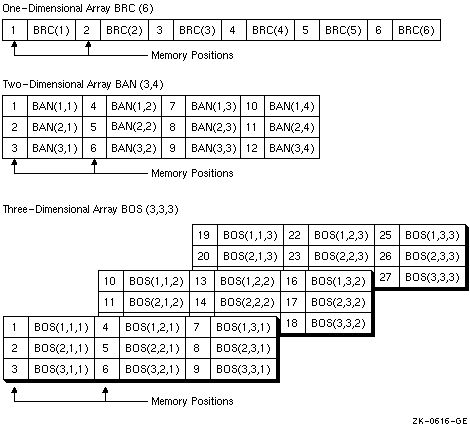Visible to Intel only — GUID: GUID-6FC5251E-CC4C-4EB1-AED2-4EA542A7287D
Visible to Intel only — GUID: GUID-6FC5251E-CC4C-4EB1-AED2-4EA542A7287D
Array Elements
An array element is one of the scalar data items that make up an array. A subscript list (appended to the array or array component) determines which element is being referred to. A reference to an array element takes the following form:
array(subscript-list)
array |
Is the name of the array. |
subscript-list |
Is a list of one or more subscripts separated by commas. The number of subscripts must equal the rank of the array. Each subscript must be a scalar integer (or other numeric) expression with a value that is within the bounds of its dimension. |
Description
Each array element inherits the type, kind type parameter, and certain attributes (INTENT, PARAMETER, and TARGET) of the parent array. An array element cannot inherit the POINTER attribute.
If an array element is of type character, it can be followed by a substring range in parentheses; for example:
ARRAY_D(1,2) (1:3) ! Elements are substrings of length 3
However, by convention, such an object is considered to be a substring rather than an array element.
The following are some valid array element references for an array declared as REAL B(10,20): B(1,3), B(10,10), and B(5,8).
You can use functions and array elements as subscripts. For example:
REAL A(3, 3) REAL B(3, 3), C(89), R B(2, 2) = 4.5 ! Assigns the value 4.5 to element B(2, 2) R = 7.0 C(INT®*2 + 1) = 2.0 ! Element 15 of C = 2.0 A(1,2) = B(INT(C(15)), INT(SQRT®)) ! Element A(1,2) = element B(2,2) = 4.5
For information on forms for array specifications, see Declaration Statements for Arrays.
Array Element Order
The elements of an array form a sequence known as array element order. The position of an element in this sequence is its subscript order value.
The elements of an array are stored as a linear sequence of values. A one-dimensional array is stored with its first element in the first storage location and its last element in the last storage location of the sequence. A multidimensional array is stored so that the leftmost subscripts vary most rapidly. This is called the order of subscript progression.
The following figure shows array storage in one, two, and three dimensions:

For example, in two-dimensional array BAN, element BAN(1,2) has a subscript order value of 4; in three-dimensional array BOS, element BOS(1,1,1) has a subscript order value of 1.
In an array section, the subscript order of the elements is their order within the section itself. For example, if an array is declared as B(20), the section B(4:19:4) consists of elements B(4), B(8), B(12), and B(16). The subscript order value of B(4) in the array section is 1; the subscript order value of B(12) in the section is 3.